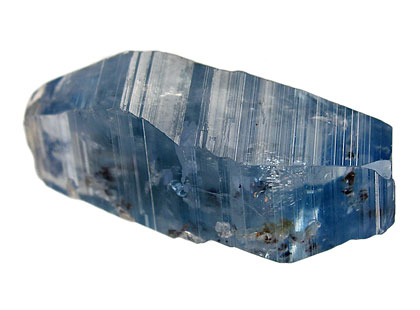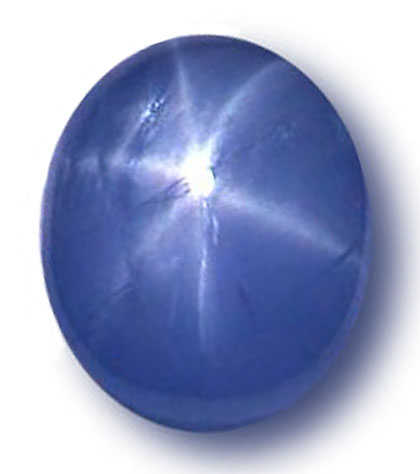Birthstones by the Month
September Birthstone | Sapphire

September Birthstone Sapphire (Corundum)
This is not a large sapphire crystal, but look it has superb color. It is a doubly-terminated floater crystal, no damage, with fine luster and the typical striations of the faces. [2]
Sapphire Mineral Form
While Sapphire is most commonly associated with blue, the gemstone Sapphire actually appears in a range of colors, except red which are Rubies.
Despite having almost identical structures, Ruby has kept its own name since it is the only red Corundum.
Sapphire crystals tend to form in barrel or spindle-shaped hexagonal pyramids.
Sapphire Facts
Named from the Greek word "for blue," Sapphires have been highly appreciated for centuries. Sapphires come in a wide variety of colors including: yellow (sometimes called golden), pink, white (also known as colorless), green, purple, orange and even black. Typically the term "Sapphire" references all shades of blue while "fancy Sapphire" could indicate any other color. The specific Padparadschah Sapphire from Sri Lanka comes in orangey pinks and is highly valued for its unique coloring. Aside from Sri Lanka, Sapphires are mind all over the world including Thailand, Madagascar, Australia, USA and more.
The characteristics of Sapphire
Some mid-grade Sapphires have been known to display a greenish pleochroism which means when the gemstone is held up to light at certain angles, multiple colors are displayed. Sapphire is a safe stone to use in all jewelry applications due to its high Mohs hardness at 9. The only gemstone harder than Sapphire is the diamond with a Mohs hardness of 10.

Sapphire Crystal
An intensely colored sapphire of high quality. It has not just color but great luster too. [3]
Cut and Clarity for the September birthstone
Blue Sapphires are typically expected to display at least minor inclusions. While the more transparent the better, "silk" Sapphire is still valued and cut into cabochons. These Sapphires contain dense, parallel groupings of Rutile needle-like inclusions causing a clouding of the stone. These inclusions have been known to exhibit asterism when carved into cabochons, which is a star-like formation. When held up to the light, the star or asterisk shape moves when rotated. Higher quality Sapphire’s are cut into a wide range of shapes chosen to highlight where color is most concentrated within the rough. Sapphire’s are often cut with a deep center and most of the weight of the stone remaining above the girdle.
The value of Sapphire
The most valuable Sapphire’s display an intense cornflower blue hue and have come to be known as Kashmir Sapphire. Color saturation is the most important aspect when determining the value of Sapphire. Unlike many other gem-quality stones, blue Sapphires range greatly in size ranging from points to hundreds of carats. Large Sapphires are more common than similar-sized Rubies, though still as precious.
Is Sapphire ever treated?
Sapphires undergo a number of different treatments to occasionally improve color or help reduce inclusions for higher clarity. The most common of these methods is heat treating. Since heat treating is an industry standard, most Sapphire in jewelry is enhanced. Truly natural Sapphire with intense coloring and few inclusions is rare and highly valuable. Sapphires also undergo diffusion treatments to artificially alter the color. This is similar to heat treating, but Sapphires with diffusion enhancements tend to be low in value even though they have a high color saturation.
More about Sapphire the September birthstone
Rough Sapphire is sometimes found in igneous rocks called pegmatite. While the gemstone itself can be large in size, it is uncommon to find a large deposit.
According to metaphysical beliefs, Sapphire is said to dispel evil thoughts and even increase inner peace when worn. For this reason, during Medieval times, Sapphire was associated with the heavens.
The American Gem Society's September Birthstone page has more information to help you buy from knowledgeable and skilled jewelers and to help you make the most informed buying decision.
Image Attribution
- By Parent Géry (Own work) [Public domain] via Wikimedia Commons
- Rob Lavinsky, iRocks.com – CC-BY-SA-3.0 [CC BY-SA 3.0], via Wikimedia Commons
- Rob Lavinsky, iRocks.com – CC-BY-SA-3.0 [CC BY-SA 3.0], via Wikimedia Commons
- By Astynax (Own work) [Public domain], via Wikimedia Commons
- By Mitchell Gore [Public domain] via Wikimedia Commons


